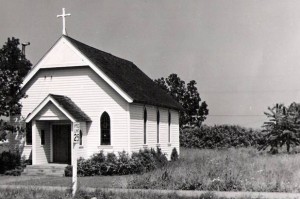The first St.Luke’s church came into being as the result of the determination of a woman who was truly ahead of her time. Sarah W. B. Hucksford served as an Army nurse in the Civil war, and after a trip to Italy in the 1870’s for a government mission she returned to New York and became a doctor. Her marriage to a sea captain from Seattle, Thomas Jones, brought her to Sequim where she practiced medicine. She was an Episcopalian, and wanted a church to attend, so in 1893 she gathered all the other Episcopalians she could find who lived in the area and they decided to build one. She and her husband donated some land, lumber was donated by a local mill, and although money was scarce, work (much of which was also donated) on the new church began. Progress was slow, but they built a strong frame and by finishing only what was necessary, they were able to hold the first service in 1894. As money came in, more work was done until the little church was  completed in 1896. It was named St. Luke’s – it has been speculated that this name might have come from the church where Sarah Jones had been confirmed, or that she wanted to honor the physician Luke because of her profession.
completed in 1896. It was named St. Luke’s – it has been speculated that this name might have come from the church where Sarah Jones had been confirmed, or that she wanted to honor the physician Luke because of her profession.
The next chapter in our history took place in 1908, when the land on which the church stood was sold, and as no land deed had been filed, the new owners ordered the church to be moved. This was quite a feat, with the lack of equipment and the narrow, winding roads – but with the help of almost every man in the community, the church was moved to its location on north Sequim Avenue (where Spruce St. is now) donated by the C. F. Seal family. St. Luke’s became an organized mission in January of 1943, and the first Vestry was appointed.  During the early years, St. Luke’s shared clergy with Port Angeles and, later, Port Townsend and services were sporadic. But the people persevered, and the church began to grow and the 1950’s saw the re-establishment of a Sunday School, the formation of a Junior Guild to help the Senior Guild, and the addition of a choir.
During the early years, St. Luke’s shared clergy with Port Angeles and, later, Port Townsend and services were sporadic. But the people persevered, and the church began to grow and the 1950’s saw the re-establishment of a Sunday School, the formation of a Junior Guild to help the Senior Guild, and the addition of a choir.
As activities in the church increased, it became apparent that a Parish Hall was needed, and construction was started in October of 1955 and the building (located adjacent to the church) was dedicated in August of 1956. Growth continued during the 60’s as St. Luke’s had, for the first time, a full time resident vicar. A Men’s Club was organized in 1971, and they began the tradition (which continues to this day) of preparing a pancake breakfast on the first Sunday of every month. By 1974, St. Luke’s was able to be self supporting, and paperwork was filed in 1978 to bring St. Luke’s to Parish status. St. Luke’s was received as a Parish at the 1979 Convention, with the Rev. Homer Smith as the first rector of St. Luke’s Parish.
As the church continued to grow, discussions about a replacement church began, but the sentimental attachment to the old church made this a difficult process. Plans for a church to be built on acreage on Brown Road in 1975 fell through, but the search for a new location began again in the mid 1980’s and two acres were purchased on North Fifth Avenue in 1985. In April of 1990, the city of Sequim agreed to buy the land on which the old church stood because they wished to extend Spruce Street. Construction was begun on the current church, and the old church was purchased by local entrepreneurs who remodeled it and a restaurant was opened there (first Jean’s Deli, then Lippert’s, and today Blondie’s Plate).
The new church was consecrated on August 2, 1992. The old church featured a Triptych stained glass window over the altar that had been given as a memorial to Mrs. William Grant in 1894, and this was removed and brought to the new St. Luke’s along with the eight ‘medallion’ windows that had been installed around 1948. The windows for the new nave were created by Rich Riesau in May of 1993. In 1993 a breezeway between the parish hall and the church and a covered entrance to the parish hall were added.
Throughout the long history of our church, there have been times of joy, frustration, enthusiasm, discouragement, times when no services could be held due to lack of clergy able to make the long trip to Sequim, times of growth and vitality – but the dedication of both laity and clergy has never wavered and has provided ongoing strength. As noted in a published history of St. Luke’s – ‘…it is the Holy Spirit, dwelling in the members of this Body of Christ that makes it all possible.’
